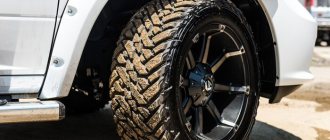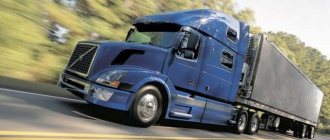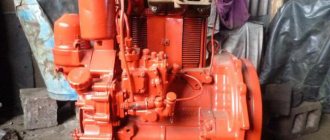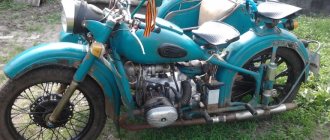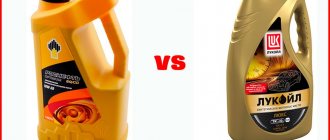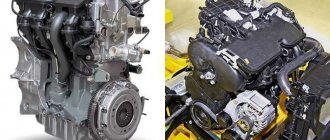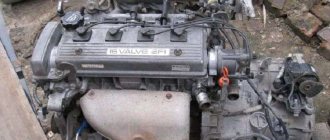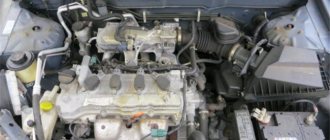Cars and tractors with YaMZ 536
The six-cylinder YaMZ 536 turned out to be more powerful and economical, based on the volume of the internal combustion engine. As a result, diesel quickly gained credibility among many manufacturers of various equipment and was installed on trucks: Ural, GAZ, MAZ, ZIL, tractors: Onega, Altai, Vologda, Chelyabinsk, Lipetsk, Vladimir tractor plants. The motor was also used on medium and small capacity buses: Volzhanin, PAZ, LiAZ, KAVZ, combine harvesters: Krasnoyarsk, Rostselmash and Taganrog plants. YaMZ536 was also used by the Ministry of Defense to complete tracked and wheeled vehicles, on stationary installations and other products.
A little history
The history of YaMZ development goes back almost 100 years. The first power units of the series replaced the outdated YaAZ diesel engines. Today, the YaMZ 236 and 238 engines, which faithfully served the fatherland for almost 70 years, are considered legendary.
But no matter how much you modernize a classic, it will remain a classic. To replace the 236th and 238th in 2010, the plant management decided to develop a new generation of power units. How the YaMZ-536 engine appeared in the world, as well as its younger brother, the 534th.
History of the creation of YaMZ 536
The modern, four-stroke diesel engine belongs to the line of engines of the 530 family of the Yaroslavl plant. This family is represented by two main models: YaMZ534 and 536. These engines are considered by some experts to be updated models 204 and 206 engines of the Yaroslavl plant. But this judgment is extremely incorrect. The old engines were two-stroke, they were replaced by four-stroke, V-shaped diesel engines back in 1962. Soon they completely replaced the obsolete two-stroke engines of the 204 and 206 models from production. At this time, no one had even thought about the 530 family of diesel engines. The only thing that the 536 and 206 engines have in common is the number of cylinders; otherwise, these are completely different models.
The family of 530 engines at Avtodiesel was developed from a new sheet of paper. And the world-leading Austrian engineering and design corporation AVL List was involved in upgrading the new engine to world standards. Participation in the development of a new engine from a well-known engineering company meant that the new diesel engine began to comply with European environmental safety standards Euro 4, with the possibility of finalizing Euro 6 standards.
The legendary development of the YaMZ 530 family began back in 1992. Then, three leading automobile manufacturing plants in Russia: YaMZ, GAZ, ZMZ agreed to develop a new diesel, four-stroke engine for medium-sized PAZ buses and GAZ trucks.
It was decided to carry out design work in the city of Yaroslavl, and they decided to launch serial production in the Volga region. First they wanted to create a four-cylinder engine, and then on its basis, by adding two cylinders, to design a six-cylinder, modern diesel engine. Initially, it was decided to use a gas distribution mechanism with four valves in each cylinder and separate cylinder heads.
In the first developments of the engine, a mechanical, in-line injection pump was used; later they decided to use individual high-pressure injection pumps in the fuel system; they were located inside the BC. These first engines were equipped with a turbine and were planned to be used for buses of the Gorky and Pavlovsk factories. The estimated maximum diesel power at the border is 140 hp. But this motor was not completed. Market needs have changed. The multi-purpose military vehicle GAZ 3937, created on the basis of an armored personnel carrier, required an engine whose power should not be less than 170 hp. It was for this car that the first diesel engine of the new generation was created. It received the YaMZ 460 marking.
By 2001, based on this internal combustion engine, three diesel versions were developed: with three, four and six cylinders. These were: three-cylinder, with a power of 110 hp, four-cylinder, with a power of 160 hp, and the hero of our story, YaMZ 536. All created engines underwent laboratory tests on domestic vehicles. YaMZ 536 exceeded all expectations; it turned out to be a serious engine with a power of 240 hp. It was tested on a LIAZ bus and a Ural truck.
In 2003, Russian engineers turned to engineers from the leading Austrian company AVL List for an audit of the technical data of new diesel engines. Foreign experts noted the high level of new engines. And in 2005, a joint design group was created in Yaroslavl to improve the YaMZ530 engines to world standards. The group worked in the Austrian design center in the city of Graz. And a year later, in 2006, the new YaMZ 536, with a capacity of 312 hp, was tested. Cooperation with Austrian specialists made it possible to create a diesel engine that complied with Euro 3 and Euro 4. Serial production was supposed to begin in 2009, but the crisis that broke out confused all plans. But all the bad things pass, and thanks to a loan from Vnesheconombank in May 2010, the construction of new industrial buildings was resumed. And a year later it was completed, including installation of equipment. At the end of 2012, YaMZ536 entered mass production.
Creation of the 530 series of diesel engines
At the beginning of the 2000s, the company began developing new promising diesel engines of the YaMZ-530 series, as part of a joint project with the Austrian group AVL List. After successful testing of prototypes, serial production of YaMZ-534 and YaMZ-536 engines began in 2012.
In a short period, the plant mastered over two hundred different modifications, as well as configurations of these engines, which ensured their extensive use. The new power units, including the YaMZ-536, had technical characteristics similar to, and sometimes superior to, the world’s best engines in the following parameters:
- operating time (resource);
- environmental standards (Euro-4; Euro-5);
- efficiency.
A special feature of the design of the motors is their adaptability for operation in various climatic conditions, including diverse domestic ones. In addition, the traditionally increased unification, despite the large number of variants of the YaMZ-536 (6 cylinders) and 534 (4 cylinders) in-line engines produced, reduces the cost of production and also increases maintainability.
This is interesting: YaMZ-7511 technical characteristics: crankshaft and timing gear
Modifications of the YaMZ 536 power unit
During production, a large number of analogues and modifications of the base engine were developed. The engine was adapted for different types of equipment, which is why many versions of the 536 ICE appeared. The main difference between all versions of the internal combustion engine is different ECU software, which changes the settings for the operation of the fuel injection pump.
Here is a list of the main modifications:
YaMZ 536
The base power unit is considered to be the YaMZ536. Its power, 2300 rpm, is 312 hp, and the torque at 1500 rpm is 1226 Nm. The base engine is installed on a MAZ truck: 6312, 5363, 5550, 5440; Ural 6370. It was also used on LiAZ 6212, 5256, 6213 buses. The base power unit complies with EURO 4 environmental safety parameters.
The base engine had several analogues:
- YaMZ-53601, a close copy of the main engine, it used the EOBD II system. This version was equipped with MAZ cars: 5440, 6312, 5363, 5550, 6501; as well as LiAZ buses: 6212, 5256, 6213;
- another analogue of the base engine is YaMZ-53602, there is no valve that recirculates exhaust gases, here the design of the exhaust tract has been changed and the ECU settings have been changed. This analogue of the base motor corresponds to the 4th environmental class according to rules 96-02. YaMZ-53602 is used on Ural-NEXT trucks: 4420, 4320, 5557; on boats: KS 951, 162, 165, 950, 164, 169; Ameta, Flagship;
- another analogue of the main engine, labeled YaMZ-53603. It uses the EOBD II system and an SCR catalyst, thanks to which this version complies with EURO 5. The diesel power has increased at 2300 rpm to 330 hp, and the torque at 1500 rpm is 1275 Nm;
- YaMZ-53604, an analogue of the main engine, running on gas.
YaMZ 5361
The YaMZ 5361 modification differs from the base engine by setting the injection pump to 270 hp, power at the same crankshaft speed, the torque has correspondingly decreased to 1166 Nm, at 1500 rpm. The motor was used on a MAZ truck: 5440, 6312, 5363, 5550.
This modification also has its analogues:
- YaMZ 53611, an analogue of the previous modification, differs from it in the installed EOBD 2 system. Diesel was found on the same MAZ models as YaMZ 5361;
- YaMZ-536111, this is a version of YaMZ 53611, used on LiAZ 5293 and LiAZ 5292 buses;
- YaMZ-53613 is an analogue of the base engine, converted to EURO 5. An SCR catalyst and EOBD2 are installed here. This internal combustion engine is intended for LiAZ buses: 6212, 5256, 6213.
YaMZ 5362
A modification that was designed for the Ural truck. But later it was installed on other vehicles, such as: LiAZ5292, 5256, 5293; and at ChSDMDZ-98.
The YaMZ 5362 modification had its own analogues and copies:
- YaMZ 53621, copy of 5362, but with EOBD;
- YaMZ 53622, the same 5362, but with a TKR80.05.13 turbine installed, without an EGR valve, with a modified intake pipe design. The motor complies with the 4th environmental class, according to rules 96-02. The engine was equipped with the Ural Next: 4320, 5831, 3255, 5557;
- YaMZ 53623, version for EURO 5, power at 2300 rpm min., 275 hp, and torque at 1500 rpm min., 1177 Nm.
- YaMZ 53624, version 5362, running on gas, its power is 287 hp.
YaMZ 5363
Modification for KrAZ and MAZ trucks. The power of this version at 2300 rpm min., 240 l., forces, torque at 1500 l., forces, is 1049 Nm. The power unit was installed on the MAZ 5550 and MAZ 5363.
In the fourth modification, there were also analogues:
- YaMZ 53631, copy 5363 with EOBD2 system;
- YaMZ 53633, version, customized for turbocharger. Used on the LiAZ5292 bus.
- YaMZ 5364, a modification specially created for the LiAZ 6213 and LiAZ 6212 buses. Engine power, at 2300 rpm min., 285 hp, power. Torque 1130 at 1500 rpm min.
The modification has a number of copies:
- YaMZ 53642, copy 5364, it lacks an EGR valve, a TKR80.05.13 turbocharger is installed and the design of the intake pipe has been changed. The engine is used on a KrAZ 4420, 5831, 4320, 5551, 5557 vehicle, complies with EURO 4;
- YaMZ 53644, gas version of the internal combustion engine, its power is 260 hp.
- YaMZ 53645, analogue of 53642, is adapted for use on tractors and combines;
- YaMZ-53646, analogue of 53642, with reduced power of about 202 hp. Used on RM-Terex TX 270 and WX 202.
YaMZ-5366
Tractor modification for environmental class 4, in accordance with safety rules 96-02. The power of the power unit is 262 hp. The motor used is RM-TerexTG200.
The modification is no exception regarding the presence of analogues:
- modification YaMZ-53662, is a copy of 5366. Its power is 219 hp. The motor used is RMTerexTG 180;
- YaMZ-53663, an analogue for EURO 5, has 246 hp, power, used on LiAZ 5292, 5262, 5293 buses.
YaMZ 5368
YaMZ 5368 is a version of the basic model, adapted to operate diesel generators.
Technical characteristics of the YaMZ 536 engine and its modifications
| Model, equipment | YaMZ-536 (basic) | YaMZ-536-10 | YaMZ-536-30 | YaMZ-536-40 | YaMZ-5361 |
| Number and arrangement of cylinders | L6 (in-line) | ||||
| Cylinder diameter, mm | 105 | ||||
| Piston stroke, mm | 128 | ||||
| Cylinder displacement, l | 6,65 | ||||
| Power, kW (hp) | 229 (312) | 198,5 (270) | |||
| Rotation speed, rpm | 2300 | ||||
| Maximum torque, Nm (kgfm) | 1226 (125) | 1166 (119) | |||
| Frequency at maximum torque, rpm | 1300–1600 | ||||
| Minimum specific fuel consumption, g/kW h (g/hp h) | 194,5 (143) | ||||
| Weight, kg | 640 | 635 | 640 | ||
| Resource, thousand km | 1000 | ||||
| Applicability | Trucks, chassis, dump trucks, MAZ tractors (B5 family) 4×2, 4×4, 6×2, 6×4, 6×6, 8×4 weighing up to 36 tons, road trains up to 44 tons, incl. . MAZ-6501V5 | Ural 6x4 vehicles weighing up to 38 tons, road trains up to 44 tons; incl. "Ural-63705" | KrAZ vehicles weighing up to 30 tons, incl. KrAZ-N12.0 | Articulated city buses weighing up to 28 tons LiAZ-6512, -6213; commuter buses weighing up to 16 tons LiAZ-5256 | Trucks, chassis, dump trucks, MAZ tractors (B5 family) 4×2, 4×4, 6×2, 6×4, 6×6 weighing up to 30 tons, road trains up to 36 tons |
| Model, equipment | YaMZ-5362 | YaMZ-5362-10 | YaMZ-5363 | YaMZ-5364 | YaMZ-5364-10 |
| Number and arrangement of cylinders | L6 (in-line) | ||||
| Cylinder diameter, mm | 105 | ||||
| Piston stroke, mm | 128 | ||||
| Cylinder displacement, l | 6,65 | ||||
| Power, kW (hp) | 176,5 (240) | 210 (285) | |||
| Rotation speed, rpm | 2300 | ||||
| Maximum torque, Nm (kgfm) | 900 (92) | 1049 (107) | 1130 (115) | ||
| Frequency at maximum torque, rpm | 1300–1600 | ||||
| Minimum specific fuel consumption, g/kW h (g/hp h) | 193 (142) | 194,5 (143) | |||
| Weight, kg | 630 | 640 | |||
| Resource, thousand km | 900 | 1000 | 800 | 1000 | |
| Applicability | City and suburban buses weighing up to 18 tons LiAZ-5256, LiAZ-5296; LiAZ-5293 | Trucks "Ural" 4x4, 6x6 weighing up to 26 tons, road trains up to 32 tons | Trucks, chassis, dump trucks, MAZ timber tractors (B5 family) 4×2, 4×4, 6×2, 6×4, 6×6 weighing up to 26 tons, road trains up to 32 tons | LiAZ buses | Ural 6×6 trucks weighing up to 30 tons, road trains up to 36 tons |
| Model, equipment (Rules No. 96-02) | YaMZ-53602-10 | YaMZ-53622-10 | YaMZ-53642-10 |
| Number and arrangement of cylinders | L6 (in-line) | ||
| Cylinder diameter, mm | 105 | ||
| Piston stroke, mm | 128 | ||
| Cylinder displacement, l | 6,65 | ||
| Power, kW (hp) | 229 (312) | 176,5 (240) | 210 (285) |
| Rotation speed, rpm | 2300 | ||
| Maximum torque, Nm (kgfm) | 1226 (125) | 900 (92) | 1130 (115) |
| Frequency at maximum torque, rpm | 1300-1600 | ||
| Minimum specific fuel consumption, g/kW h (g/hp h) | 190 (140) | ||
| Weight, kg | 620 | ||
| Resource, thousand km | 600 | ||
| Applicability | Ural off-road vehicles 4x4, 6x6 weighing up to 38 tons, road trains up to 44 tons, incl. Ural-32552; 6×6 Ural-4320-78, Ural-44202-70, Ural-55571 | Ural off-road vehicles 4×4, 6×6 weighing up to 26 tons, road trains up to 32 tons | Ural off-road vehicles 6×6 weighing up to 30 tons, road trains up to 36 tons |
Description of the power unit corresponding to EURO 4 and EURO 5
The new YaMZ 536 diesel units and its modifications comply with the European requirements for exhaust gas purification EURO 4 and EURO 5. To meet these requirements, an exhaust gas recirculation system (EGR for short) was included in the design of the new engine. It was also planned to install a catalytic converter, which was equipped with a filter that required periodic replacement. All these devices were needed to comply with EURO 4. The engine complied with the parameters of rules 96-02 even without this.
The engines of the 536 model, complying with EURO 5, have been further developed. For this purpose, as on imported cars, the exhaust system was equipped with a selective catalytic reducer, a catalytic converter and a muffler converter. The motor power supply and control system was a Common rail battery type, it had high injection energy, up to 1800 bar. The control system was used from Bosch. The power supply system included: high pressure HP, fuel accumulator line, ramp, injectors, dosing module. The fuel supply system had several control sensors: a crankshaft phase detection sensor, a rotation speed sensor, a sensor indicating fuel pressure, an air temperature sensor coming from the turbine, a sensor measuring fuel temperature, a sensor indicating coolant temperature and a motor lubrication pressure sensor.
The cylinder block, cylinder head, crankshaft, connecting rod mechanism, bearings of the YaMZ-536 engine, and other important internal combustion engine mechanisms are designed for a fuel ignition pressure of 210 bar. All components and mechanisms are designed with a large margin of safety and the possibility of increasing motor power.
The drive of gear-type units is located on the flywheel side. It provides low noise level of torsional vibrations. YaMZ 536 has a closed ventilation system for crankcase gases; its design is located in the cylinder head cover; it does not require maintenance or constant care.
Design features of the YaMZ-5Z6 E4 and E5 engines
To ensure compliance of the YaMZ-5Z6 power unit with the Euro-4 environmental standard, its design uses an exhaust gas recirculation system (EGR), as well as a catalytic converter equipped with a replaceable filter. At the same time, the parameters of “Rule No. 96-O2” are achieved without the use of the EGR system and converter.
The YaMZ-5Z6 E5 engines are maximally unified with their counterparts of the Euro-4 standard. In order to increase the environmental requirements of Euro-5, the following are installed in the exhaust system, as on imported analogues:
- selective catalytic reduction (“SCR”) system, which consists of a dosing module and a tank for an aqueous solution of urea - AdBlue reagent - 32% solution of (NH2)2C0.
- selective catalytic converter (muffler-neutralizer).
Fuel supply and control systems on YaMZ-5Z6 engines are of the Common Rail (ECRS) battery type, with high injection energy and electronic control, from . It provides an injection pressure of 18OO bar, and includes: a high-pressure pump with a dosing module, a fuel accumulator line (rail), injectors. The following control sensors operate in the fuel supply system: rotation speed, phase, fuel pressure, fuel temperature, charge air temperature, charge air pressure, coolant temperature, oil pressure.
Technical data YaMZ 536
The four-stroke, six-cylinder, diesel engine YaMZ 536, the cylinders of which are placed in one row, was released in 2012. Its production began at the Avtodiesel enterprise, Yaroslavl Motor Plant.
- Material of manufacture, especially durable cast iron. The liners are wet type and have direct contact with the coolant.
- The gas distribution system is lower shaft, the camshaft is located in the BC. Gear drive, from the crankshaft. The camshaft acts on the valve rocker arms using push rods. There are 24 valves, 4 for each individual cylinder.
- The piston stroke length is greater than the cylinder diameter: 128 and 105 mm, respectively. Motors with such parameters are considered long-stroke; their peculiarity is that they have a high efficiency output.
- The exact engine capacity is 6650 cubic centimeters, the compression ratio of the combustion chamber is 17.5:1.
- Engine power, depending on the modification, at 2300 rpm, from 212 to 330 hp, torque at 1500 rpm, ranges from 950 to 1275 Nm.
- Environmental compliance standards with European environmental safety standards EURO 4, EURO 5.
- On certain modifications, a TKR80.05.13 turbocharger is installed.
- The weight of the power unit is 650 kg.
Fuel consumption
Fuel consumption at a speed of 60 kilometers per hour is about 30 liters per 100 kilometers. The permissible consumption of motor lubricant is up to 0.2% of fuel consumption.
Oil
Engine oil: 10W40, 5W40, 15W40. The amount of oil is 22.5 liters. The manufacturer recommends changing the oil after 30 thousand km, but it is better to cut this period in half.
Engine life
The actual service life of an internal combustion engine with proper, timely maintenance and normal operation is about 1 million km.
Engine components layout
| Right view | Front view | Left view |
YaMZ-536 engine diagram. Right view | YaMZ-536 engine diagram. Front view | YaMZ-536 engine diagram. Left view |
|
|
|
Design features of the YaMZ 536 internal combustion engine cylinder block
BC YaMZ 536 is made of gray, highly durable cast iron. It is the basis for connecting all components and mechanisms into a single power plant. At the top of the block there are slots for wet cartridges. Each socket in the cylinder has an annular groove in the upper part under the edge of the liner and a corresponding hole on the lower shelf of the block.
The groove and hole are made coaxially. The material used to manufacture the sleeves is phosphorous cast iron. The sleeves in the block are centered along the outer edge of the collar. The edges of the water jacket form a closed contour around the socket in the cylinder. Thus, the lower and upper plates of the cylinder parts of the BC are connected, strengthening the overall structure of the block.
Cylinder head device 536 model
The cylinder head is a block type and is common to all six cylinders. The material used is a special cast iron alloy. The cylinder head is attached to the BC using a bolted connection.
To cool the cylinder head, a system of cavities is provided for the circulation of coolant. The cylinder head contains: valves with bushings and springs, traverses, valve rocker arms, injectors and rocker arms. All these assembled parts are a single mechanism designed to supply the combustible mixture to the combustion chambers of the internal combustion engine.
crank mechanism
The crankshaft of the internal combustion engine is made together with counterweights from stamped steel. It is a dynamically balanced fully supported mechanism with hardened connecting rods and main journals. The crankshaft is installed with main shafts on the BC supports.
Between the supports and the main journals there are sliding bearings. Lubricant is supplied to the sliding bearings under pressure through special oil lines. The flywheel is cast from gray, highly durable cast iron. A steel ring gear is pressed onto it. It is necessary to start the engine with the starter. The flywheel is attached to the end of the crankshaft using ten bolts.
A common hardened plate is installed between the end and the flywheel. To dampen torsional vibrations, a liquid damper is used; a pulley is built into it at the rear for temporary drive of auxiliary units. This device copes well with the task assigned to it, but it is vulnerable; mechanical damage can quickly render it unusable.
The design of the connecting rod is made in the form of an I-beam. The lower head has an oblique connector. To increase the load-bearing capacity of the connecting rod, the upper head was made in the form of steps; near the rod it is wider. The sliding bearings of the connecting rod and main journals of the crankshaft have a removable design.
Design features of the YaMZ 536 piston group
The piston has a one-piece design. It has three grooves machined for piston rings. The groove of the upper compression ring has an insert made of especially durable cast iron. To increase the contact strength of the pistons, the pin bosses were made in the form of steps. The bottom is shorter than the top. The combustion chamber is located centrally, coaxially with the piston surface. To ensure good cooling of the piston, there is a closed cavity in its head in which oil circulates.
Oil enters the piston by fixed nozzles, which are installed on the central oil line of the BC, opposite all six pistons. In the oil cavity of the pistons, two identical channels are provided, having a vertical arrangement. The purpose of these channels is to supply and drain oil into the piston cavities. Constant circulation of oil in the piston cavity ensures reliable cooling.
The piston rings are split, cast iron, they are installed in grooves specially prepared for them. The piston pin is hollow, steel, floating type. This means that it moves freely in the piston bosses. Which has a positive effect on the operating life of the ShPG. Axial movement of the pin is prevented using retaining rings located in the grooves of the piston bosses.
Design and arrangement of the gas distribution mechanism
The gas distribution mechanism has an upper valve arrangement and a lower crankshaft arrangement. The valves are driven using pushers, rocker arms, rods and traverses. The gas distribution mechanism performs the task of admitting air into the cylinders and exhausting exhaust gases, according to the operating order of the cylinders and changing engine strokes. Each cylinder is provided with two intake and two exhaust valves. The valves are driven through traverses.
The components for the gas distribution mechanism are:
- camshaft;
- drive gear;
- rear bearing with thrust flange;
- pushers and rods;
- rocker arms with adjusting screws installed on them;
- rocker axis;
- traverses;
- valve;
- axle struts;
- springs for valves with fastening elements;
- bushings that serve as valve guides.
Lubrication system design
The lubrication system of the 536 model has a mixed wet sump design. The motor lubricant is cooled in an oil-liquid heat exchanger. The oil pump, which has a gear design, sucks engine lubricant from the crankcase through a coarse filter. Then, under pressure, the oil moves through an oil-liquid heat exchanger and an oil purification filter to the central oil line. Then it goes through special oil channels to the rubbing parts and oil nozzles. Having fulfilled its functions, the engine lubricant flows into the crankcase, while splashing and lubricating other engine parts.
Cooling system 536 model
The YaMZ engine has a liquid circulation cooling system, which includes:
- water pump or water pump;
- oil-liquid heat exchanger;
- fan;
- thermostats;
- radiator for the exhaust gas recirculation system;
- main water radiator;
- air-to-air system required to cool the charge air.
The oil-liquid heat exchanger, pump and thermostats form a single cooling module located on the right front side of the diesel engine. When the engine is running, a centrifugal water pump circulates coolant in the system.
Design and principle of operation of a turbocharger
To ensure maximum efficiency of the power unit, it was equipped with a turbocharger. Which supplies additional compressed air using the energy of exhaust gases. A larger amount of air ensures better combustion of the fuel supplied to the engine cylinders.
All modifications of the 536 engine, with turbocharging, use a centripetal, radial turbine, as well as a centrifugal compressor. The latter is equipped with a specially designed bypass valve. At the turbine outlet, the temperature of the charge air can increase up to 180 degrees. Air must be cooled before it enters the cylinders. These functions are performed by an air cooler.
Cooled air has a beneficial effect on reducing harmful substances in exhaust gases. The 530 engines of the YaMZ family are equipped with an exhaust gas recirculation system. A fifth of the gases, which have a high heat capacity, are redirected back into the cylinders, thereby reducing the formation of carbon dioxide. All the innovations used for the ICE 536 model put it on par with the best Western-made diesel engines.
| Designation: | YaMZ-5367 |
| Manufacturer: | JSC AVTODIZEL (YaMZ) GAZ Group |
| Product type: | Engine and its components |
| Name: | Diesel engine |
Euro 4.
| 450 | |
| Maximum torque, Nm | 1470 |
| 1 | |
| Ural-63095 Typhoon-U (Mine protected vehicle) | 1 |
Share…
| ||||||||||||||||||
| List of products... | ||||||||||||||||||
Last changed companies |
| Mechatroniq Systems Inc |
| Horiba Mira |
| RoboteX, Inc. |
| Endeavor Robotics |
| MacroUSA |
| Roboteam |
| General Motors Defense |
| Milanion LLC |
| Zhong Tian Zhi Kong Technology Holdings Company |
| Arquus |
| Elektroland Defense |
| FIBERTECH CO.,LTD |
| Praesidium Global Pty Ltd |
| Panus Assembly CO.,LTD |
| Polska Grupa Zbrojeniowa SA – PGZ |
| List of companies... |
Latest article discussions |
| Orbital ATK receives $16 million to create the next generation of 120 mm tank ammunition... (10/14/2015) Messages - 1 |
| Oto Melara and Diehl evaluate Vulcano SAL guided munitions... (07/29/2013) Messages - 1 |
| Russian Airborne Forces: in 2013, the first 10 modernized BMD-4M combat vehicles will enter the troops... (05/12/2013) Messages - 2 |
| Heavy metal: the feasibility of extending the service life of Abrams tanks... (05/09/2013) Messages - 5 |
| The Polish Minister of Defense announces the possible purchase of Leopard 2A4 or A5 tanks... (05/08/2013) Messages - 1 |
Latest forum posts |
| Technical descriptions of engineering equipment, books... Messages - 5 Robert ( 15:13 04/24/2016) |
| For spacecraft they will use... Messages - 1 v-nayke ( 21:42 12/01/2015) |
| Did you know that...... Messages - 363 illex ( 15:18 04/15/2013) |
| Equipment for ammunition disposal... Messages - 1 Evgen74 ( 11:05 01/21/2013) |
| Russian-English glossary on armored vehicles... Messages - 30 illex ( 10:37 11/23/2012) |
| List of forums |
Home | Articles | products | companies | countries | quantities | museum | contracts | Rights and Disclaimer | Contact | English
© ATEN, 2002-2015
Typical malfunctions of YaMZ 536
This power unit, like any equipment, has its weak points, of which there are not many:
Turbine
First of all, you need to pay attention to the serviceability of the turbine. There are known cases when a turbine failed at the mileage mark of 50 thousand km. A turbine breakdown is not so scary as the consequences after its breakdown. The thing is that when a turbocharger fails, its wear products can get into the fuel system. If measures are not taken in time, fuel injection pump parts, ShPG and others may be damaged, which will ultimately lead to expensive repairs. Typically turbines run up to 300,000 km. At the first signs, which are: whistling, increased play, high oil consumption, the turbine needs to be replaced with a new one.
EGR valve
The second most important weak point of this internal combustion engine is the EGR valve. Combustion products accumulate there. Their seals can cause the valve to jam. The area of contamination must be cleaned regularly. The problem can be solved more simply by shutting off the valve and setting the ECU to work without an EGR valve.
Zhor oil
The engine often experiences increased consumption of motor lubricant. The problem here is worn valve guides. The problem is solved by replacing the valve guides.
As can be seen from the above, the YaMZ 536 internal combustion engine does not bring many problems to its owners. Of the entire line of the 530 engine family, in terms of technical characteristics and user reviews, the 536 turned out to be the most successful, powerful and reliable modification, which earned it a place in the assembly shops of the Yaroslavl plant for many years to come.
How much oil to fill in the YaMZ 536 engine
Years of production – since 2012
The YaMZ-536 with an in-line arrangement of six cylinders has a rather bulky design, but on the other hand, this arrangement ensures smooth and uninterrupted operation, which is very important under heavy loads that trucks usually face. In addition, an in-line diesel engine has a long service life and has balanced performance characteristics. Modern components in this engine were borrowed from foreign manufacturers, which made it possible to adapt it to Euro-5 and Euro-6 environmental standards. Compared to the base family, the latest versions of the YaMZ-536 have a reduction in harmful emissions and higher efficiency, and the engine life can reach 800,000 km.
Diesel engines since 2012
YaMZ-536, 6.6 l (202-330 hp), oil volume - 22.5 liters; tolerance and viscosity: API-SL, CI-4, ACEA – E7; SAE 5W-40, 10W-40, 15W-40
